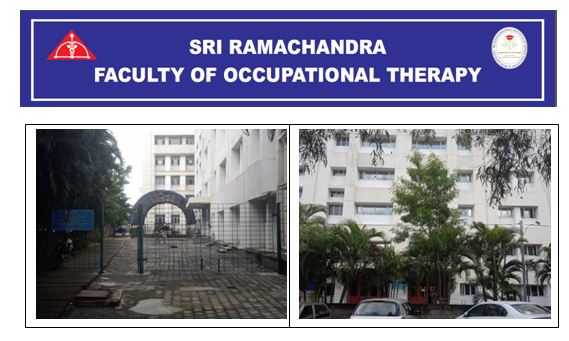Sri Ramachandra Faculty Of Occupational Therapy

Faculty of Occupational Therapy offers the B.O.T program (Bachelor of Occupational Therapy - four and half year). Students in B.O.T program learn the skills in Health conditions, Human Occupations, Evaluation, Intervention and Research methods in Occupational Therapy Clinical practice is required before graduation program. The students are given hands on clinical training in the attached Sri Ramachandra Hospital & Medical Centre
Keywords:
Occupational Therapy referred to as OT, is an integral part of the healthcare system. Occupational Therapists focus on developing, recovering, or maintaining the daily living and working skills of people with physical, mental or cognitive impairments. Occupational Therapists practice in the wide range of areas like pediatrics, neurological science, musculoskeletal conditions, mental health, geriatrics etc. The focus of Occupational Therapy is to approach the patient’s care in a holistic manner.
The practice of Occupational Therapy means the therapeutic use of everyday life occupations with persons, groups, or populations (clients) to support occupational performance and participation. Occupational Therapy practice includes clinical reasoning and professional judgment to evaluate, analyze, and diagnose occupational challenges (e.g., issues with client factors, performance patterns, and performance skills) and provide Occupation - Based & Client – Centered interventions to address them.
Occupational Therapy services include habilitation, rehabilitation, and the promotion of physical and mental health and wellness for clients with all levels of ability-related needs. These services are provided for clients who have or are at risk for developing an illness, injury, disease, disorder, condition, impairment, disability, activity limitation, or participation restriction. Through the provision of skilled services and engagement in everyday activities, Occupational Therapy promotes physical and mental health and well - being by supporting occupational performance in people with, or at risk of experiencing, a range of developmental, physical, and mental health disorders. The practice of Occupational Therapy includes the following components:
Evaluation of factors affecting activities of daily living (ADLs), instrumental activities of daily living (IADLs), health management, rest and sleep, education, work, play, leisure, and social participation, including
Evaluation of factors affecting activities of daily living (ADLs), instrumental activities of daily living (IADLs), health management, rest and sleep, education, work, play, leisure, and social participation, including
- Context (environmental and personal factors) and occupational and activity demands that affect performance.
- Performance patterns including habits, routines, roles, and rituals.
- Performance skills, including motor skills (e.g., moving oneself or moving and Interacting with objects), process skills (e.g., actions related to selecting, Interacting with, and using tangible task objects), and social interaction skills (e.g., using verbal and nonverbal skills to communicate)
- Client factors, including body functions (e.g., neuromuscular, sensory, visual, Mental, psychosocial, cognitive, pain factors), body structures (e.g., cardiovascular, digestive, nervous, integumentary, genitourinary systems; structures related to movement), values, beliefs,and spirituality.
- Methods or approaches to identify and select interventions, such as
- Establishment, remediation, or restoration of a skill or ability that has not yet developed, is impaired, or is in decline
- Compensation, modification, or adaptation of occupations, activities, and Contexts to improve or enhance performance
- Maintenance of capabilities to prevent decline in performance in everyday life Occupations.
- Health promotion and wellness to enable or enhance performance in everyday Life activities and quality of life
- Prevention of occurrence or emergence of barriers to performance and participation, including injury and disability prevention
- Interventions and procedures to promote or enhance safety and performance in ADLs,
- IADLs, health management, rest and sleep education, work, play, leisure, and social
Participation, for example: - Therapeutic use of occupations and activities.
- Training in self -care, self - management, health management (e.g., medication management, health routines), home management, community/work integration, school activities, and work performance
- Identification, development, remediation, or compensation of physical, neuromusculoskeletal, sensory –perceptual, emotional regulation, visual, mental and cognitive functions; pain tolerance and management; praxis; developmental skills; and behavioral skills
- Education and training of persons, including family members, caregivers, groups, Populations, and others
- Care coordination, case management, and transition services
- Consultative services to persons, groups, populations, programs, organizations, and communities
- Virtual interventions (e.g., simulated, real-time, and near - time technologies, including telehealth and mobile technology)
- Modification of contexts (environmental and personal factors in settings such as home, work, school, and community) and adaptation of processes, including the application of ergonomic principles.
- Assessment, design, fabrication, application, fitting, and training in seating and positioning, assistive technology, adaptive devices, and orthotic devices, and training in the use of prosthetic devices
- Assessment, recommendation, and training in techniques to enhance functional mobility, including fitting and management of wheelchairs and other mobility devices.
- Therapeutic Activities including tasks and methods to increase motion, strength, and Endurance for occupational participation.
- Remediation of and compensation for visual deficits, including low vision rehabilitation.
- Driver rehabilitation and community mobility.
- Management of feeding, eating, and swallowing to enable eating and feeding performance.
- Application of physical agent and mechanical modalities and use of a range of specific therapeutic procedures (e.g., wound care management; techniques to enhance sensory, motor, perceptual, and cognitive processing; manual therapy techniques) to enhance performance skills
- Facilitating the occupational participation of persons, groups, or populations through modification of contexts (environmental and personal) and adaptation of processes.
- Efforts directed toward promoting occupational justice and empowering clients to seek and obtain resources to fully participate in their everyday life occupations
- Group interventions (e.g., use of dynamics of group and social interaction to facilitate learning and skill acquisition across the life course).




